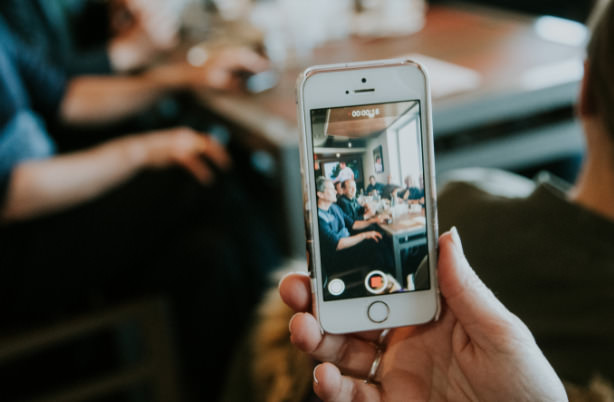Mobile Video Ethnography Dives Into the Teenage Mind
What shapes the identities of teens today? California ad agency BSSP wanted to reach beyond data-driven assumptions to find out, going deep into the minds of Generation Z. Using mindswarms mobile video surveys, they captured teens’ unfiltered responses. What they learned is that Gen Z’s attitudes center around purpose, authenticity, and technology. (Oh, and transparency.)
What is it like to be 17IN17?
Seventeen interviews with 17 seventeen-year-olds—it’s our initial exploration into the lives and minds of teenagers today. It’s our attempt at digging beyond data-driven assumptions to get to their mind-sets and motivations.
Much has been reported and debated about Generation Z, this new breed of future consumer that marketers are trying to familiarize themselves with before their spending powers become fully realized. We wanted to get past the stereotypes and statistics. We wanted to get to know them as distinct individuals with their own unique stories and points of view, not just as a collective demographic cohort. To do so, we partnered with mindswarms, a mobile video ethnography firm, and interviewed 17 seventeen-year-old participants from across the states through a series of mobile video surveys.
In some ways, not much has changed. It’s still about human biology, after all. Seventeen-year-olds are in that transitional phase between high school and college, with their teenage years disappearing into young adulthood. They are increasingly independent, and starting to think about the future. They are social creatures whose lives revolve around family and friends.
In other ways, it’s completely new territory. They are entrenched in technology and living out these progressive years online, under intense scrutiny.

We’ve identified three key themes that have shaped their self-identities.
I. Exposure to global issues drives their sense of purpose.
- As diverse members of this world, today’s teens are forced to confront the pervasive global issues that seep into their daily lives and flood their newsfeeds. They often reject the beliefs presented to them by their families and local communities, presumably because the Internet gives them access to alternative perspectives from a global community. They do not I. Exposure to global issues drives their sense of purpose. passively observe, but actively voice their opinions, shaping their own personal brands through these issues. Social media often becomes an amplifier for these points of view, whether it pertains to gender, race, religion, politics, or global warming. At times their beliefs are so actively rejected by their local communities that it seems as if they’re experiencing their teenage rebellion in the form of a social stance.
In their own words:
I grew up in the Christian homeschool community, and they’re not very accepting of gay feminine guys. I was taught that it was wrong. Growing up, I was taught that being gay was wrong, being feminine was wrong, being different was wrong. And I don’t believe that…
Being queer, I’d like to give out help to other gay people… So, I decided I want to be different in the sense that whenever I come out, I want to do it to help others. I’m very, very vocal about it online because that is worth more than money to me.
~ Jake S.
I live in a highly populated Hispanic community with all these stops that are being put up or all these people that are being sent up… [People are] being pulled over and cops these days just assume if you’re Hispanic or Mexican or whatever, they’re like, ‘Okay, well, let me see your… Are you a citizen of the United States?’ It motivates me to kind of speak on behalf of them or speak up for them.
~ Angelina
I’m from a really small hometown, like a really southern part of the United States. [Having empathy] definitely helped me see the people around me, like how they were raised and their values, and I lost a lot of friends because of it…
Basically they would think that maybe I was racist because I’m speaking out about it [police brutality]. It’s scary that there’s a lot of people out there that can’t even go to the store at night without worrying about dying, and there’s people who can get pulled over, and pull a gun out, and maybe because of their skin color or their background they won’t even die…
When something crazy happens—like when Trump does something, or someone dies at the hands of a police officer—during those times I’m probably on social media the most, because I know people are saying crazy things and I want to have my input on it
~ Katlyn
Causes that matter to me? I’m a black activist. I believe in equality of the races and gender equality. I don’t know if that makes me a feminist but I like to think I’m a forward-thinking person, liberal… I donate to causes when I can. I like to buy T-shirts and state my opinions on social media.
~ Myhani
I’m a really big supporter of the Black Lives Matter movement because I don’t like seeing people get hurt just because of who they are. They can’t change who they are. I tweet about it and I post about it on other forms of social media. And me and my friends talk about what we can do to help them.
~ Skylar

- However, they are not more likely to purchase a brand that is purpose driven, because many don’t believe that most profit-driven brands can be authentic.
In their own words:
Brands are inauthentic because most of them just speak up about things that are important at the time, whatever is going to bring them the most benefit.
~ Katlyn
I don’t think companies should get involved in these [issues] because they’re supposed to be serving the consumer. And if the consumer has a different idea or political view than the manufacturer or person who’s making the product, it could mean that they may not buy the products, which could harm the company.
~ Jake M.
They’re just trying to please what they think the consumers [want], how they think they feel. So it won’t be their true opinions, and it won’t be meaningful to them or to the consumers.
~ Alexander
No matter the brand, the point of it is just to make money regardless if it’s great quality or not.
Angelina
Implications for brands:
1. Be aware of the diversity of today’s teens. They are different from previous generations and expect brands to recognize this. Some brands have, and are taking steps to banish stereotypical portrayals of gender in advertising. Unstereotype Alliance is a collective comprised of Unilever, UN Women, and several of the world’s largest advertising and tech players working together to eradicate outdated stereotypes in advertising.
There’s been particular progress in the beauty space, with both CoverGirl and Rimmel London signing seventeen-year-old social media influencers James Charles and Lewys Ball, respectively, as brand ambassadors, recognizing their efforts in shattering gender-based beauty ideals.
2. Stay off the purpose bandwagon unless you are actively involved in resolving the issue at hand, or if it is intrinsic to who you are. Otherwise, Gen Z will see right through you.
3. That said, you don’t have to be a purpose-driven brand in order to succeed with them. Offering a high-quality product or service, supported by good customer service with a real human touch, is significantly more important.
In their own words:
If you didn’t have technology, I feel like you could gain things that we’ve lost through technology, like communication skills and being face-to-face with somebody.
~ Anna
It bothers me because it’s like… Because we’re hanging out and it’s kind of like we plan to be together, but you have something in between like spending the time together, where it’s like a wall.
~ Angelina
Without these things, I think my life would be a little different, because I’d be unplugged from the rest of the world, pretty much. But I wish that honestly none of this stuff was ever invented, because things would be so much better without technology. People would actually go out and do things and be more connected with the actual world.
~ Camryn
I think that I’d just be missing out on stuff that, honestly, doesn’t really matter. So I think that I would gain something from that. I would have the opportunity to invest my time in something that could be far more productive, like going to the gym, reading a book, or getting a new hobby that actually improves me.
~ Katlyn
I think I would learn a lot more about myself and what hobbies that I like, and I feel that I would be outside more than staying inside and being a homebody.
~ Nisean

- Still others insisted that their smartphone was more additive than distracting. In school, it could be an educational tool. Among friends, it distracts from, but also supports, their social interactions as a source of information and entertainment. By themselves, it becomes an excuse to look and keep busy or a way to connect to their passions.
In their own words:
A lot of the older generation, they feel like my generation is too attached to their cell phone, and I really don’t feel like there’s a problem with it. I know a lot of older people, they’re not really in tune with technology, and they don’t understand what technology can do, so in the classrooms, I remember I would have teachers who didn’t want us to use our phones at all, and then we had some teachers that actually let us use our phones to look up stuff and actually incorporate in classrooms. They need to do that. I don’t really find it invasive at all.
~ Jhonte
I really only use it if I have nothing else to do. Nothing to do and nobody to talk to. I scroll and scroll… If I know I’m about to go somewhere and I’m not about to know anyone, I’ll probably bring my phone because you don’t want to just be awkward in the corner staring. I feel like everybody is staring at me so I’m like I got to have something to look down at… Half the time I’m not even reading what’s on the screen. I just need to look like I’m doing something.
~ Katlyn
Like when I was [in] Europe, I would have hated to not have my phone, because there was so many pictures I wanted to have taken of me that it would have really sucked if I didn’t have my phone. All those memories, because I’m definitely going to [get] those printed out and put up somewhere. I think it’s really important to get stuff off your phone and onto some paper, or something.
~ Katlyn
Implications for brands:
1. Don’t be too quick to judge. What looks antisocial to older generations is another way to be social for them. Brands can help facilitate these live social sessions. For example, the popularity of augmented reality app Pokemon Go saw people hunting for Pokemon creatures in real-life environments on their smartphones, with their friends.
2. Do more to understand not just what teens are doing on their phones, but with them. Create tools or work with other partners that empower them to explore and exploit their passions. Coca-Cola partnered with Musical.ly, a lip-syncing and video-sharing app with a core audience between the ages of 13 and 24, for its Share a Coke and a Song campaign. Users shot videos of themselves sharing a Coke with friends or family.
3. Remember that they are true digital natives who don’t appreciate being interrupted. Annoying advertising can be skipped, and the next best piece of content is a simple tap, click, or swipe away. Your communication needs to be compelling enough to be sought out.
- Today’s teens grew up watching Millennials take on massive amounts of debt to pursue a college degree, only to be greeted by sky-high rental prices and dismal career prospects. Millennials moved home after graduation and are now notorious for delaying major life events like marriage and having children, often due to financial stress. When we asked today’s teens about their visions for the future, they described low-risk lives of financial stability, and do things now to set themselves on that path.
In their own words:
I guess just it being my own money and knowing that I worked for it and I think about more when I spend, if I shop and it’s a $30 shirt or something, it’s like, ‘Okay, do I really want to spend that much money for this thing?
~ Angelina
I want to become a CPA. I’m really good at math, and they make a pretty decent amount of money… They say money doesn’t buy happiness, and I do think that’s the truth. Because if you’re not happy with yourself, nothing’s going to make you happy. But I do think that it makes things easier,
if you don’t have to worry about bills and all these other things.~ Anna

Implications for brands:
1. Today’s teens expect more for their money. They’re skeptical of advertising and tech savvy enough to see through marketing BS. When asked for reasons why they like the brands they do, they pointed to functional product benefits. While we don’t recommend losing the emotional story, today’s teens may need to be given the practical reasons to choose one brand over another.
2. Maybe it was Millennials who championed the art of borrowing (e.g., Rent the Runway), but it’s teenagers today who are demanding it across verticals. Brands that offer access will win out over those that offer ownership. The simple reason: accessibility has less risk than ownership. Consider the following ways to allow them to try before they buy:
a. Subscriptions like Spotify allow consumers to pay month-by-month so the product can continue to prove its value to gain reuse.
b. Personalized trial boxes like Ipsy give consumers a sampling of things they may like, bringing the Sephora experience home.
c. Make buying and returning easy, with free shipping. If it arrives and doesn’t fit, last, or work as expected, teens need to know they can send it back for free and without hassle.
d. Of course, there are some purchases that can’t be sampled. For these, consider ways that virtual reality could give prospective buyers a sense for what’s to come, as IKEA did with its virtual showroom.Have we cracked today’s teens? We hardly think so. Do we know what it takes to reach and engage them? We have some ideas. To truly understand them, we encourage brands and marketers to go out and have real conversations with people, as opposed to relying too heavily on generalizations. Instead of interpreting some ambiguous data point, spend time with them and ask them.
BSSP is one of the largest independent agencies on the West Coast. Adweek named BSSP Small Agency of the Decade, and Outside magazine recognized the agency by naming it one of the Best Places to Work in America. For further information, please contact Patrick Kiss at pkiss@bssp.com or visit www.bssp.com.
The mindswarms community provides people all over the world a platform to easily share authentic opinions and experiences through self-recorded videos to impact the creation of some of the world’s most innovative products and brands.
ACKNOWLEDGMENTS
Special thanks to the people who shared their personal stories and insights with us as part of this mindswarms study.